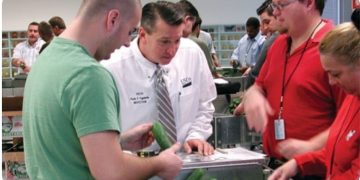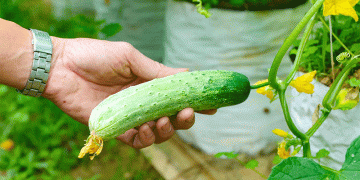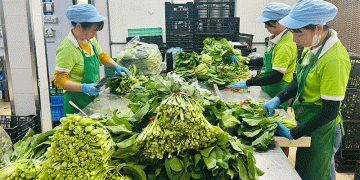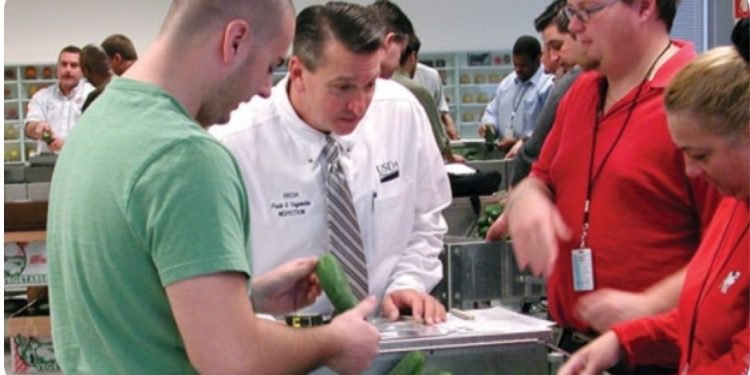Technology for inspecting fresh-cut produce from field to home, commercial or industrial kitchen is as sophisticated as it’s ever been.
But the human factor remains just as important.
Experts say fresh-cut produce is safer and better in quality than ever. Between industry training courses, HACCP (Hazard Analysis and Critical Control Points) procedures, monitoring technology, audits, lab testing (at some sites) and other safeguards, processors have the capability to meet consumer expectations for safe and fresh-looking and -tasting products.
But all along the way, inspection in one form or another is the key.
“It starts off with the incoming supply,” said United Fresh Vice President of Food Safety and Technology David Gombas. “You can’t make good fresh-cut out of bad whole produce.
“You have to start out with the best quality stuff.”
Equipment is also a huge factor, he adds.
“The fastest way to lose quality in a fresh-cut operation is dull knives,” Gombas said. “The sharper the knife, the better the quality of the product.”
At the third-generation, family owned McEntire Produce in Columbia, South Carolina, Executive Vice President Tom Lovelace said HACCP principles guide the company’s process from beginning to end. Behind that, McEntire has made a strategic decision to have separate quality and safety departments and staff so that resources aren’t diluted and each area receives equal emphasis.
“The whole process evaluates critical control points and monitors at precise intervals,” said Lovelace.
And it’s a process that relies on equal parts technology and people.
“You have mechanical systems in place – automatic systems in place – but it’s the people that do two things,” Lovelace said. “They design the steps needed to be taken in the first place. And the other thing they need to do is make sure the interventions are actually working.
“There are verification steps that need to be done, and they are done by humans. There is no substitute for experienced, highly qualified people.”
The company maintains relationships with specific growers who must follow its “rigorous specifications.” Among other things, McEntire produces fresh-cut leafy greens, onions, peppers, tomatoes, cabbage and carrots, predominantly for foodservice in quick-serve restaurants.
“We have people visit growers to verify that they are adhering to our standards,” Lovelace said. “It’s a huge part of what we do, both from a quality as well as a food safety standpoint.”
Thoroughness continues through transport and arrival at the receiving door. Depending on where the produce is coming from, it can be as much as five days between harvest and arrival at McEntire’s processing facility, so starting out with quality product and maintaining the cold chain is all the more essential.
McEntire requires that its produce is shipped in trucks that bear “single-use non-resealable seals” affixed once loading is complete. If the seal has been broken upon arrival, an entirely different process is employed to handle it, which may include rejecting the load.
“Care, custody and control is a big part of our raw materials program,” Lovelace said, noting that the company requires temperature monitoring all along the way.
Produce is inspected upon arrival – as is the truck it came in, to ensure cleanliness.
From there, how it’s inspected and handled depends on the commodity. Heads of iceberg lettuce come in a lot cleaner than, say, loose leafy greens.
“Your lines are designed to handle that,” Lovelace said. “There are different attributes at different points in the process that you look for.”
Inspection by the human eye is a key step, as workers look for and remove bruised lettuce leaves, or defects in onions or tomatoes, for example. Whether it gets cut before washing or vice versa, most produce gets rinsed several times. Technology kicks in to electronically monitor water and microbials.
At McEntire, all product goes through a metal detector to make sure no foreign metal objects are present before it’s boxed for shipping.
Gombas described what he saw while observing production at a major processing plant where all bags of lettuce were inspected as they came off the line.
“There was 100 percent inspection of those bags,” he said. “As it was coming off the packaging line, there was somebody inspecting (to make sure that) there was nothing overtly wrong with the product.”
Some plants do microbiological testing of product upon arrival at the plant and of packaged product before it’s released.
Optical sorters have also made a big impact on the inspection process – particularly since laser technology replaced the cameras of the 1990s for screening lettuce, said Rudi Groppe, president and CEO of Heinzen Manufacturing International and one of the instructors for the University of California Davis Postharvest Technology Center’s Fresh-Cut Products Workshop.
“They’re looking for glass, wood, metal … any rodents, snake, frog parts – all those different things,” Groppe said. “And the ability to detect chlorophyll was really the turning point, because instead of just using a camera image you’re looking at it for color. With the invention of the laser and with LED optics … they can determine the translucency level.
“Camera technology would say it’s going to be a good product. With the laser, and high-speed computers, it can sense the color” and thereby discern between, say, a leaf of green lettuce and piece of green glass.
Groppe estimates between 60 and 70 percent of processors today use optical sorting equipment. McEntire is one of them.
However, Groppe believes the next frontier for sorting technology would be to mitigate post-sorting losses for processors by running rejected product through a second sorting cycle.
“Say if you’re running a line at 6,000 pounds an hour and you may have five lines, with a 10 percent reject rate, that’s a large amount,” Groppe said. “It could be taking down quite a bit of good material with what it perceives as bad.”
Bjorn Thumas, director of marketing development/food for TOMRA, said his company’s Nimbus freefall laser sorter and belt-based camera and laser sorter called Genius have capability to integrate a three-way sorting module. Featuring two ejector modules, they allow processors to create separate rejection streams.
“High-speed, precision air guns remove off-spec products and foreign material in two steps,” he said. “In some cases, the second reject stream is sorted a second time.”
So far, the three-way and re-sort processes are mainly being applied to green beans.
Whatever the process, though, inspecting to preserve quality and safety at every step is the foundation of a safe and successful fresh-cut program.
“My customers don’t care that I’m dealing with a variable raw material. They expect me to manage that,” Lovelace said. “They expect it to be perfect every time and it’s our job to get it that way.”
































